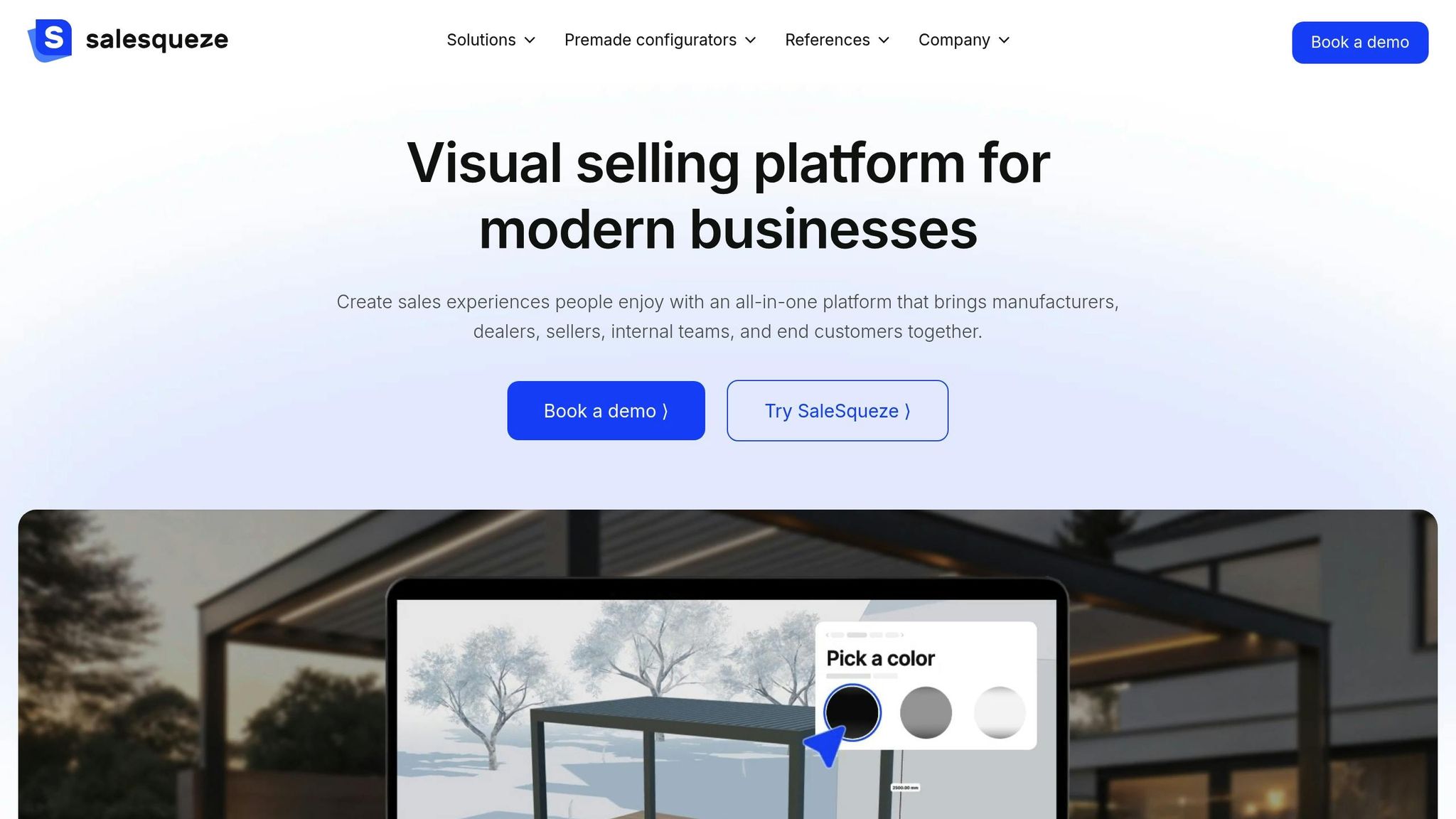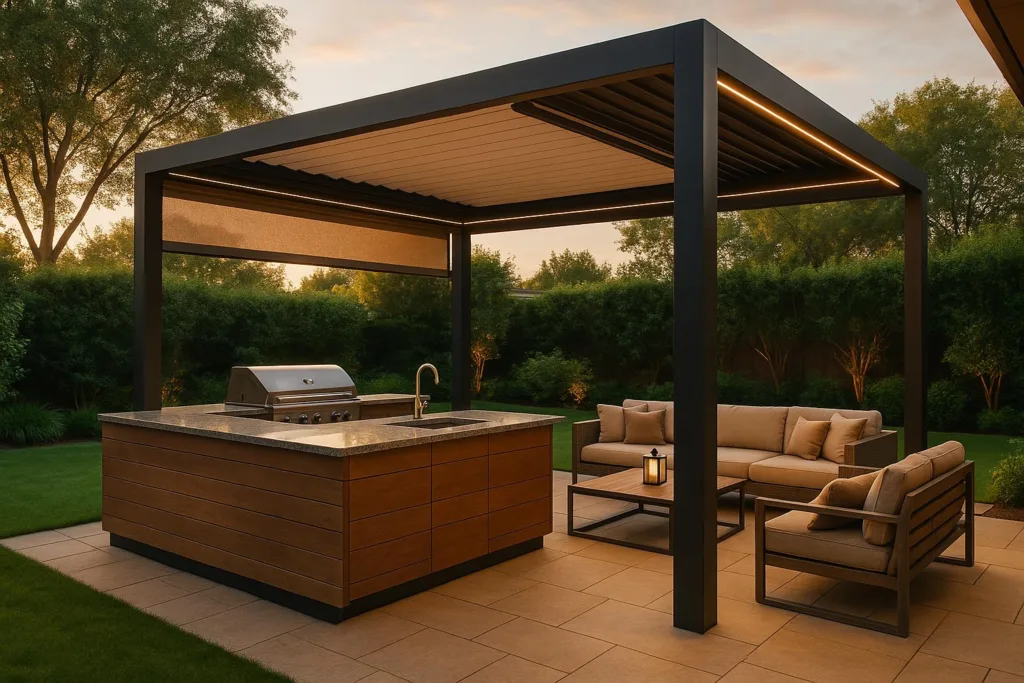Outdoor living is a booming market, with homeowners prioritizing outdoor spaces more than ever. Businesses have a lucrative opportunity to offer high-margin products like pergolas, outdoor kitchens, and custom furniture. Here’s why this trend matters and how to capitalize on it:
- Market Growth: Outdoor living structures are projected to hit $892.9M in 2024, with pergolas and patios making up 63.6% of revenue.
- Consumer Demand: 59% of consumers plan to buy outdoor furniture or accessories in 2025, and outdoor kitchens are increasingly popular for customization and premium pricing.
- Profit Potential: Outdoor furniture offers 20-30% margins, while visual configurators and AR tools boost conversion rates by up to 300%.
- Technology’s Role: Tools like 3D product configurators reduce errors, increase sales, and save time, with some businesses seeing a 40% rise in sales.
Key Takeaway: Combining high-margin products with visual configurators and automation can streamline processes, boost sales, and enhance customer satisfaction. The outdoor living market is ripe for businesses ready to embrace these strategies.
Using Visual Product Configurators for Outdoor Living Sales
What Are Visual Product Configurators?
Visual product configurators are interactive tools that let customers customize and see outdoor living products in real-time. Unlike static images or printed catalogs, these tools allow users to tweak colors, materials, dimensions, and features while instantly previewing their changes.
Since the human brain processes visuals more effectively – about 90% of all information processed is visual – these tools are particularly engaging. For outdoor living products like pergolas, outdoor kitchens, or patio furniture, this visual approach is incredibly effective. It gives customers a clear picture of how their customized product will look in their own space.
Take Aluliving, a European manufacturer of aluminum pergolas, as an example. Their Salsita CPQ configurator offers a fully interactive 3D experience. Customers can select materials, colors, layouts, and features while the system enforces design rules, updates pricing instantly, and displays a live 3D model.
“Online product configurators are essential for retailers and manufacturers of highly configurable products such as furniture, kitchen, bath, decking, and storage. They allow brands to create a personalized and engaging shopping experience for customers while also improving operational efficiency and reducing costs.” – Beck Besecker, CEO and Co-Founder of 3D Cloud
Instead of leaving customers to guess how their choices will look, these tools provide instant visual feedback, making the decision-making process much easier. Let’s explore what makes these configurators so effective.
Key Features of Effective Configurators
The best visual configurators share features that enhance customer engagement and drive sales.
Real-time 3D visualization is arguably the most impactful feature. Unlike basic 2D configurators that only let users change one element at a time, 3D tools allow for simultaneous customizations. Customers can rotate the product, zoom in, and view it from every angle to examine details. This is especially critical for outdoor living products, where size, shape, and spatial relationships matter.
A great example is TimberTech‘s 3D Deck Designer, which helps customers visualize and customize their decking projects. It offers options for board color, texture, width, and length, as well as add-ons like railings and lighting. This tool helps homeowners see their future deck before committing to a purchase.
User-friendly interfaces are another must-have. Configurators with guided prompts, FAQs, and step-by-step instructions ensure that even customers unfamiliar with customization tools can easily navigate their options.
Mobile optimization is critical, too. With so many customers shopping on their phones, a seamless experience across devices is non-negotiable.
Integration with ERP and CRM systems is another standout feature. This ensures that customer configurations flow seamlessly into the order process, eliminating manual errors and speeding up sales.
For example, Lowe’s Kitchen Planner connects directly to Lowe’s inventory and pricing systems. It allows customers to design and visualize kitchen layouts while customizing cabinets, appliances, and finishes – all synced with real-time stock and pricing data.
How Configurators Impact Sales and Margins
By combining these features, visual configurators have a proven impact on sales and profitability. Tools like these can increase conversion rates by up to 30% and speed up decision-making by 40%. When customers can visually confirm their choices, they feel more confident, reducing hesitation and boosting sales.
Data supports this: 82% of online visitors use a 3D view to better understand a product, with many interacting for 20-30 seconds or longer. This extended engagement directly correlates with higher purchase intent.
Customization tools also pave the way for premium pricing. Companies that excel in offering personalized products generate 40% more revenue than competitors. Sellers who add 3D content to their product pages see a 94% increase in conversion rates.
For instance, KitchenAid saw a 65% boost in average order value (AOV) by using a visual configurator. The tool made it easier for customers to bundle products and explore cross-sell opportunities.
Beyond sales, configurators improve operational efficiency. Companies using these tools report a 40% reduction in quote-to-cash time. Visual CPQ systems also ensure that quotes are accurate, eliminating costly errors and streamlining transactions.
“Our product configurator was a game-changer for us. It gave our customers the freedom to create their own unique engagement rings that reflect their values and personality. The ability to customize our products was a key factor in launching Brilliant Earth and sustaining our growth.” – Beth Gerstein, Co-founder and CEO of Brilliant Earth
The growing demand for configurators highlights their importance. The Product Configurator Software Market, valued at $1.1 billion in 2024, is expected to reach $3.3 billion by 2031, with a projected CAGR of 7.8%. This trend shows that these tools are no longer optional – they’re becoming essential in competitive markets.
Streamlining Sales Processes with Customization and Automation
Outdoor living projects, which average around $24,000, require efficient systems to manage the complexities of configurations, pricing, and order processing. Relying on manual processes for custom pergolas, outdoor kitchens, or multi-component patio installations often leads to inefficiencies and errors.
Automation and customization tools step in to solve these issues, eliminating bottlenecks, minimizing mistakes, and speeding up everything from the initial quote to finalizing the order. These tools are essential for improving efficiency and boosting profit margins.
Faster Quoting and Ordering with Automation
Manually creating quotes for intricate outdoor projects is not only time-consuming but also prone to errors. Automated systems simplify this process by instantly handling calculations, updating prices, and managing documentation.
When paired with interactive visual configurators (as discussed earlier), automation makes the sales process even smoother. For example, a company in West Michigan saw a 30% increase in closing rates and doubled the number of jobs sold after implementing an automated quoting system. This allowed them to respond to leads faster and generate accurate quotes without manual effort.
Integrated price books further enhance efficiency by creating instant, error-free estimates. These systems pull data from pre-configured databases, ensuring consistent pricing by automatically calculating material costs, labor rates, and markups.
Beyond speed, automation ensures consistent documentation, making order tracking, change management, and customer record-keeping much easier. This is especially important for high-value projects that may unfold over multiple phases or seasons.
Better Customization for Complex Outdoor Projects
While automation speeds up quoting and order management, customization tools address the intricate details of outdoor projects. Building custom features like pergolas often involves a mix of materials, sizes, electrical components, and site-specific requirements. Traditional sales methods often fall short in handling this complexity, leading to miscommunications and costly mistakes.
Customization tools provide a structured framework that guides both customers and sales teams through the configuration process. They ensure all critical decisions are made upfront while preventing incompatible combinations automatically.
The results speak for themselves. Businesses that excel in personalization can grow 6% to 10% faster. As McKinsey & Company notes:
“Companies with faster growth rates derive 40 percent more of their revenue from personalization than their slower-growing counterparts.”
Additionally, upgrading outdoor spaces can significantly enhance a home’s value. Research shows that improving landscaping can increase property value by 10–12%. Effective customization systems also factor in details like terrain, sunlight exposure, existing vegetation, and architectural style. This comprehensive approach not only boosts functionality and aesthetics but also helps create designated zones for specific activities.
Dealer Management and Performance Analytics
For manufacturers in the outdoor living industry, managing dealer networks effectively is key to expanding market reach and maintaining brand consistency. Performance analytics offer valuable insights to optimize dealer operations and identify growth opportunities.
Revenue fluctuations among outdoor power equipment dealers illustrate the importance of analytics. Over the past five years, revenue swings have averaged 31%. At their peak, new equipment sales accounted for 68% of revenues, while parts and accessory sales dropped to 16.1%. Conversely, when new sales dipped, parts and accessories rose to 22.6%, with an average contribution of 19.5% to total revenues. These trends highlight untapped opportunities in parts and accessories.
Analytics tools monitor key performance indicators (KPIs) like campaign delivery, click-through rates, leads, and sales to identify dealers who need additional support. Performance gap analysis sheds light on areas for improvement, such as inventory diversity, pricing strategies, and customer engagement quality. With this data, manufacturers can run targeted marketing campaigns tailored to each dealer’s budget and location, driving lead generation.
Additionally, manufacturers benefit from tracking metrics like configurator usage, conversion rates, average order values, and customer satisfaction across their dealer network. This bird’s-eye view allows for proactive support and the sharing of best practices, ensuring consistent brand quality and long-term growth.
sbb-itb-ec816af
Practical Applications: Configurators for Outdoor Living Products
Visual configurators have made it easier than ever to tackle the complexities of outdoor living customizations. They blend technology with real-world outdoor applications, improving sales and customer satisfaction. Let’s look at some examples that highlight their impact.
Pergolas and Verandas
Pergola manufacturers often deal with a wide range of material and design options, which can make customization tricky. Aluliving’s Salsita CPQ configurator simplifies this process by allowing users to select materials, colors, features, and layouts in real time. It also automates design rules and updates pricing instantly, reducing errors and enabling higher-end pricing strategies.
Similarly, TimberTech’s 3D Deck Designer provides homeowners with tailored options for decking projects. Customers can choose board colors, widths, textures, and lengths, as well as add features like railings and lighting. This tool emphasizes the benefits of specific material choices and ensures a seamless customization experience.
Outdoor Kitchens
Designing outdoor kitchens comes with its own set of challenges, requiring careful coordination of appliance layouts, countertops, cabinet finishes, and utilities. Configurators in this space allow customers to mix and match finishes while providing real-time pricing and automatic calculations. This makes decisions about grill placement, island size, and seating arrangements much easier. By reducing ordering errors, these tools also help businesses justify premium pricing.
Beyond structural projects, configurators also enhance the customization of outdoor furniture, offering a range of design options for customers seeking a personal touch.
Patio Furniture
Raymour & Flanigan, a retailer in the Northeast, uses a 3D sectional sofa configurator that lets shoppers experiment with different layouts and material options.
“With more customers browsing online before visiting showrooms, the 3D Cloud Sectional Configurator helps us deliver a seamless experience. It’s one of many tools we use to provide consistent, top‐notch service, connecting shoppers with our associates whether they start or finish their purchase online or in‐store.”
– Katharine Martin, Senior Site Merchandiser, Raymour & Flanigan
This ability to visualize arrangements boosts customer confidence and supports higher pricing strategies. In fact, 82% of shoppers use 3D views to better understand products, with online visitors engaging for an average of 20 seconds. Notably, 34% spend over 30 seconds interacting with these tools. Sellers incorporating 3D content have reported conversion rate increases of up to 94%.
These examples clearly show how visual configurators turn complex outdoor living projects into engaging, self-guided experiences, resulting in higher conversions and more opportunities for premium pricing.
Implementing High-Margin Strategies with SaleSqueze

Outdoor living businesses can flourish by embracing visual configurators and smart automation, leaving behind outdated methods. These tools pave the way for actionable strategies that boost profitability.
Key Takeaways for Businesses
- 3D configurators make complex customizations easier and encourage premium upgrades. By providing clarity, they help reduce customer hesitation and build confidence in selecting higher-priced options.
- Automation lowers operational costs and increases sales volume. With routine tasks automated, sales teams can focus on closing deals and nurturing relationships.
- Self-service tools broaden market reach without increasing costs. Letting customers configure and price products themselves means businesses can handle more prospects without needing additional staff – especially valuable during seasonal demand spikes. This approach also ensures consistent brand quality across dealer networks, safeguarding high margins.
- Data-driven insights improve pricing and product strategies. Modern configurators track customer preferences, revealing which features drive the most profit.
How SaleSqueze Supports High-Margin Strategies
SaleSqueze takes these principles and turns them into results. Its no-code configurator builder allows companies to establish complex product logic without technical expertise, while stunning 3D visuals deliver the polished presentation customers now expect.
Jaka Hrovat, Director and Co-owner of Mizarstvo Hrovat, a tiny house manufacturer, shared his experience:
“The team of experts at SaleSqueze always solves all our challenges. The product configurator helped us process 10,835 quotes through the configurator, totaling €133M in value, and saved 10,835 work hours in 30 months.”
Armat, a carport manufacturer, saw immediate improvements. Andrej Repse, Marketing Associate at Armat, explained:
“The build & price configurator is handy to our team as it saves us 15 minutes per quote. We’ve seen other results that testify to the product configurator’s value and ROI, like a 40% increase in sales.”
For businesses managing dozens of quotes each week, these time savings add up quickly, freeing up hours for customer acquisition and strengthening relationships.
Fence manufacturer Impol Servis reported even greater efficiencies. CEO Marko Zunec highlighted:
“A configurator is an excellent tool I recommend to anyone producing customizable products. The configurator automates the process from receiving an inquiry to sending the bill of materials to production. Time savings are enormous – on average, 35 minutes per quote, providing customers with an excellent user experience.”
SaleSqueze also supports manufacturers working with dealer networks through personalized pricing and permissions, ensuring consistent brand quality while increasing margins. Its seamless website integration embeds configurators directly into existing platforms, delivering advanced functionality and a smooth experience across devices.
The Sales Hub simplifies everything from initial configuration to final order, with automatic pricing updates that prevent costly errors in complex sales cycles. For outdoor living businesses aiming to grow profitably, SaleSqueze offers the tools needed to thrive in today’s digital-first marketplace – all while maintaining the personalized service that justifies premium pricing.
FAQs
How do visual product configurators improve sales for outdoor living products?
Visual product configurators simplify the sales journey by letting customers customize and view outdoor living products in 3D. This hands-on approach allows buyers to see exactly how items like pergolas, outdoor kitchens, or patio furniture will look and fit within their spaces, giving them greater confidence in their choices.
These tools not only make the buying process faster but also minimize returns by setting clear expectations upfront. By delivering a tailored and interactive shopping experience, businesses can boost sales and enjoy higher profit margins.
What are the main advantages of using automation and customization tools for outdoor living projects?
Using automation and customization tools for outdoor living spaces brings a range of benefits that can transform how these areas are used and enjoyed. Automation takes care of tasks like adjusting lighting, managing irrigation systems, or controlling climate settings. This not only saves time and effort but also ensures everything runs smoothly without constant manual intervention.
On the other hand, customization lets homeowners shape their outdoor spaces to reflect their personal style and needs. Whether it’s choosing specific lighting designs, setting up unique seating arrangements, or adding features like fire pits or water elements, these tools make it easy to create spaces that feel uniquely yours.
Beyond convenience and personalization, these tools also improve safety, enhance security, and elevate the overall look of outdoor areas. Together, automation and customization make outdoor spaces more functional, inviting, and enjoyable for everyday use or special occasions.
How can outdoor living businesses use data insights to improve pricing and product strategies?
Outdoor living businesses can tap into data insights to fine-tune their pricing and product strategies by examining real-time customer behavior and market trends. This approach helps them stay competitive while boosting profit margins through dynamic pricing adjustments.
By analyzing consumer preferences and demand patterns, businesses can pinpoint which products – like pergolas, outdoor kitchens, or patio furniture – are in high demand and how sensitive customers are to price changes. This insight not only helps streamline inventory and cut down on waste but also allows businesses to tailor their offerings to better align with customer needs. Using data in this way leads to smarter decisions and a more profitable approach to managing pricing and products.

